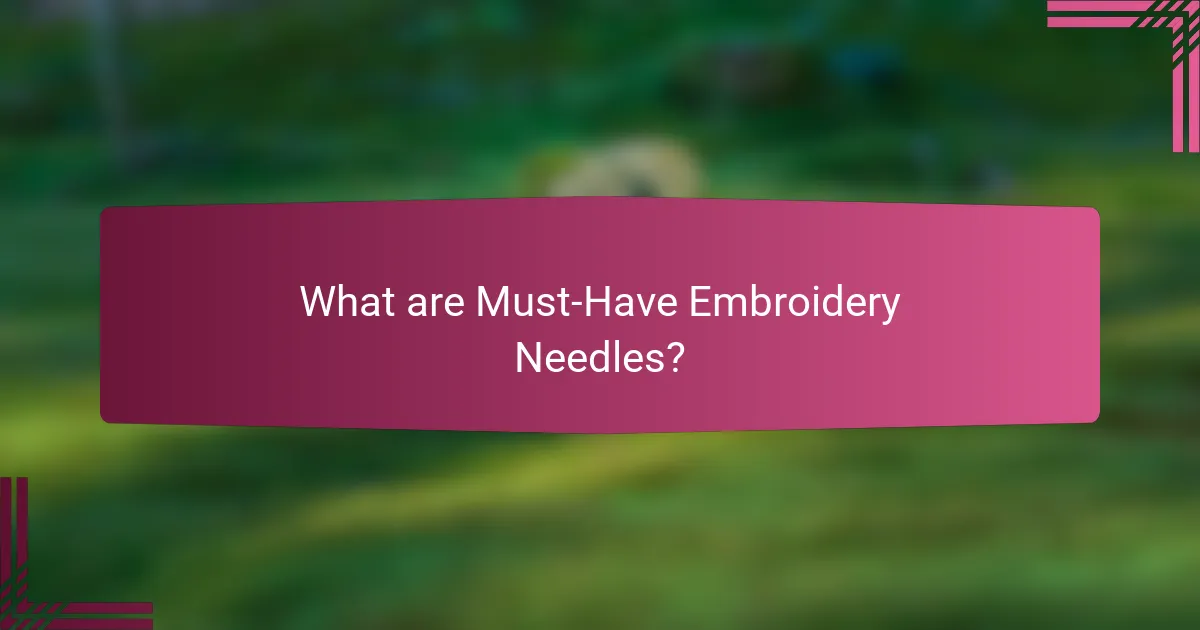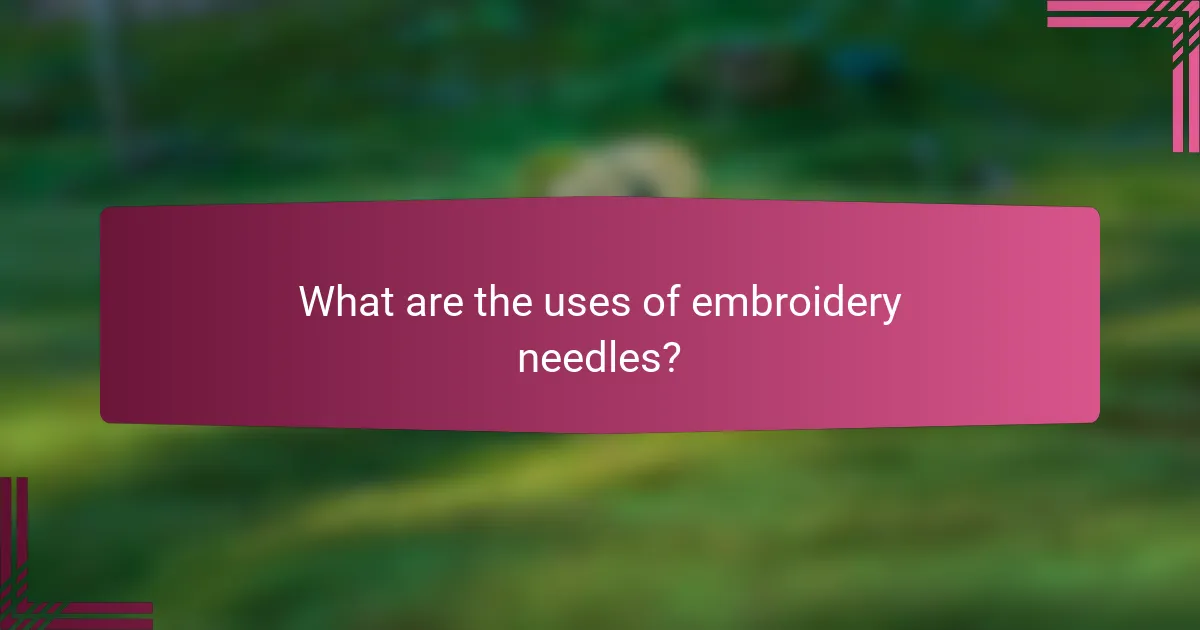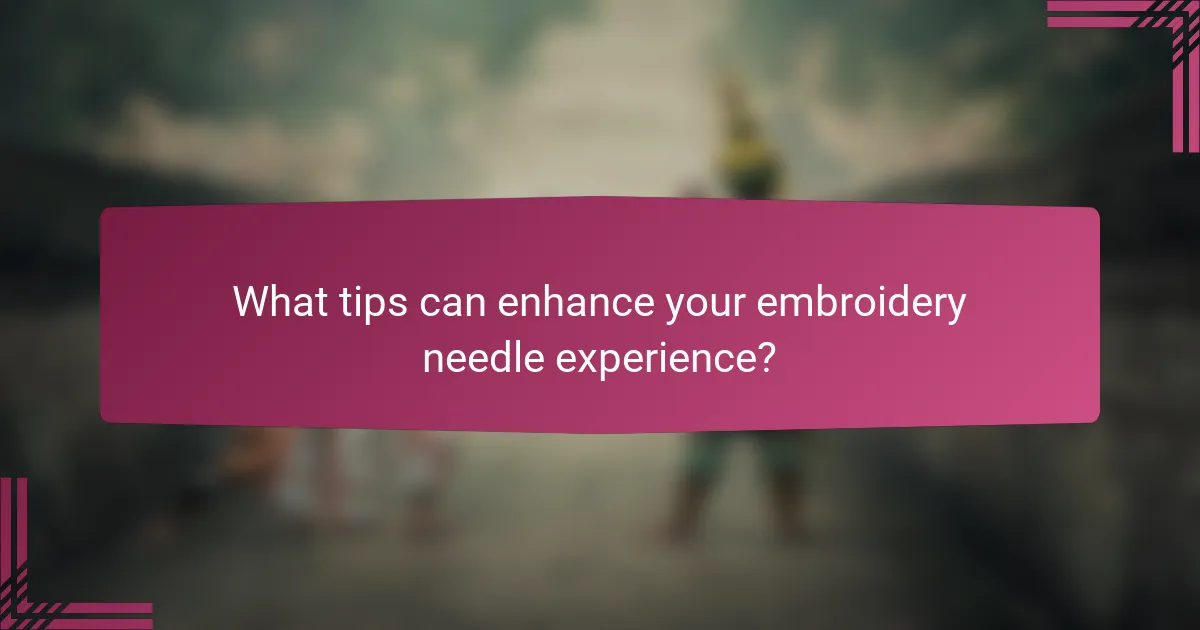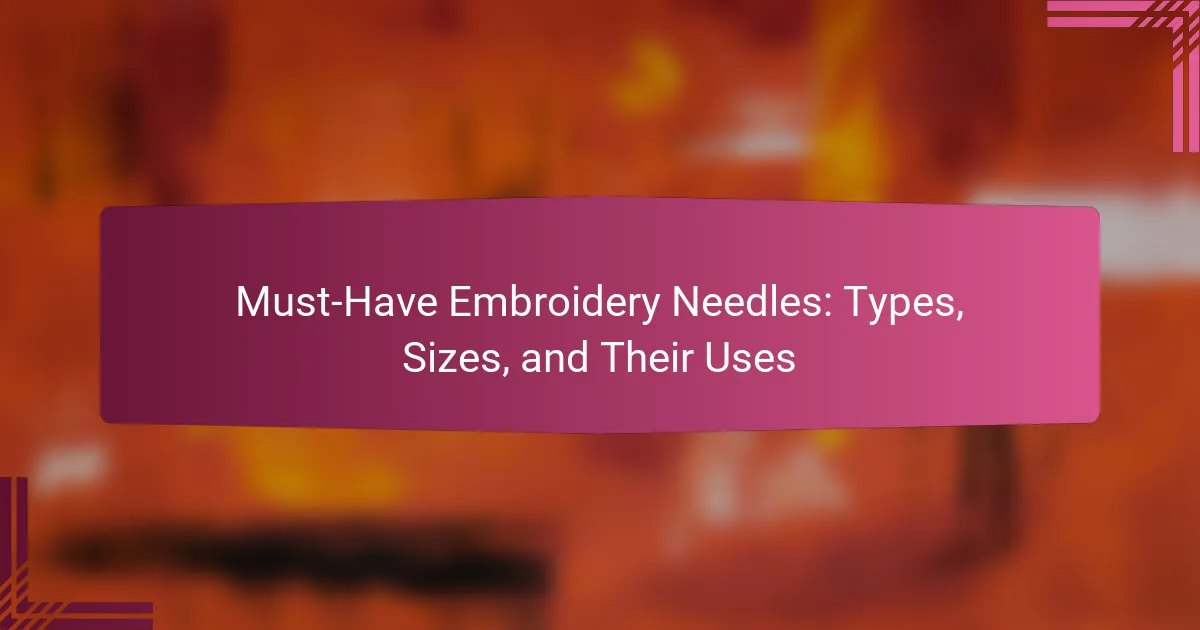
What are Must-Have Embroidery Needles?
Must-have embroidery needles are essential tools for various embroidery techniques. They are specifically designed to accommodate different types of threads and fabrics. Common types include universal, ballpoint, and embroidery needles. Universal needles work well for most fabrics. Ballpoint needles are ideal for knit fabrics, as they prevent damage. Embroidery needles have a larger eye to accommodate thicker threads. Sizes range from 60/8 for delicate fabrics to 100/16 for heavier materials. Selecting the right needle enhances stitch quality and prevents fabric damage. Proper needle choice improves the overall embroidery experience and results.
How do embroidery needles differ from regular sewing needles?
Embroidery needles differ from regular sewing needles primarily in their design and intended use. Embroidery needles feature a larger eye to accommodate multiple strands of thread or thicker embroidery floss. This design facilitates easier threading and reduces the risk of fraying. Additionally, embroidery needles often have a slightly rounded tip, allowing them to slide between fabric fibers without causing damage. In contrast, regular sewing needles typically have a sharp point, designed for piercing fabric. The differences in eye size and tip shape make embroidery needles more suitable for decorative stitching techniques.
What features define an embroidery needle?
An embroidery needle is defined by its specific features designed for decorative stitching. It typically has a larger eye to accommodate multiple threads. The shaft is usually slender and tapered for easy [censured] through fabric. Embroidery needles often have a special coating to reduce friction and enhance performance. They come in various sizes, with larger sizes suitable for thicker threads. The point of the needle is usually sharp to create clean holes in the fabric. These characteristics make embroidery needles distinct from regular sewing needles.
Why is needle choice important in embroidery?
Needle choice is important in embroidery because it affects the quality and outcome of the stitching. Different needle types are designed for specific fabrics and thread types. For instance, a sharp needle is best for woven fabrics, while a ballpoint needle is ideal for knits. Using the correct needle prevents fabric damage and ensures smooth stitching. The right needle size also influences the thread tension and stitch appearance. A needle that is too large can create holes in the fabric, while one that is too small may cause thread breakage. Therefore, selecting the appropriate needle type and size is crucial for achieving professional-looking embroidery results.
What are the different types of embroidery needles?
Embroidery needles come in various types, each designed for specific embroidery techniques. Common types include universal needles, which are versatile for many fabrics. Ballpoint needles are ideal for knits, as they slide between fibers without snagging. Chenille needles have a larger eye and a sharp point, suitable for thicker threads and fabrics. Tapestry needles feature a large eye and a rounded tip, perfect for cross-stitch and canvas work. Embroidery machine needles are designed specifically for use in sewing machines, accommodating various thread types. Each needle type enhances the stitching process based on the fabric and thread used.
What is a universal embroidery needle?
A universal embroidery needle is a type of sewing needle designed for a variety of fabrics. It features a slightly rounded tip, which allows it to penetrate the fabric without causing damage. This needle type is versatile, suitable for both woven and knit materials. Universal embroidery needles come in various sizes, typically ranging from 60/8 to 100/16. The size selected often depends on the thickness of the fabric being used. These needles are commonly used for machine embroidery, quilting, and general sewing tasks. Their design helps create smooth, even stitches, making them a popular choice among crafters.
What are specialty needles and their uses?
Specialty needles are specific types of sewing needles designed for particular tasks in embroidery and sewing. They include needles like ballpoint, twin, and embroidery needles. Ballpoint needles have a rounded tip, allowing them to glide between fabric fibers without causing snags. Twin needles are two needles mounted on a single shaft, used for creating parallel rows of stitching. Embroidery needles have a larger eye to accommodate thicker embroidery threads. Each type enhances the quality and precision of stitching for different fabrics and techniques. Their unique designs contribute to better results in specialized sewing projects.
How do ballpoint needles differ from sharp needles?
Ballpoint needles and sharp needles differ primarily in their tip design. Ballpoint needles have a rounded tip that gently pushes aside fabric fibers. This design prevents snagging and damage to knit or stretchy fabrics. In contrast, sharp needles feature a pointed tip that penetrates fabric easily. Sharp needles are suitable for woven fabrics where precision is essential. The choice between these needle types affects the quality of stitching. Using a ballpoint needle on knit fabrics ensures smooth stitching without causing runs. Conversely, using a sharp needle on knit fabrics may result in skipped stitches or damage.
What sizes of embroidery needles are available?
Embroidery needles are available in various sizes, typically ranging from size 1 to size 12. Smaller sizes, such as 1 to 3, are suitable for fine fabrics. Medium sizes, like 4 to 7, work well for standard fabrics. Larger sizes, from 8 to 12, are ideal for thicker materials. Each size corresponds to the needle’s diameter and the type of thread used. For example, size 9 is commonly used for embroidery with lightweight threads. The size of the needle affects the stitch quality and fabric compatibility.
How do needle sizes affect embroidery projects?
Needle sizes significantly affect embroidery projects by influencing stitch quality and fabric compatibility. Smaller needles create finer stitches, ideal for delicate fabrics. Larger needles allow for thicker threads and bolder designs. The right needle size prevents fabric damage and ensures smooth stitching. For example, a size 75/11 needle works well with lightweight fabrics, while a size 90/14 needle suits heavier materials. Using the incorrect needle size can lead to skipped stitches or thread breakage. Proper needle selection enhances the overall appearance of the embroidery.
What size needle should be used for different fabrics?
For different fabrics, the needle size varies. Use a size 60/8 needle for lightweight fabrics like silk and chiffon. A size 70/10 needle is suitable for medium-weight fabrics such as cotton and linen. For heavier fabrics like denim and canvas, a size 90/14 needle is recommended. Finally, for very heavy fabrics, like upholstery, use a size 100/16 needle. These recommendations ensure optimal stitching and prevent fabric damage.

What are the uses of embroidery needles?
Embroidery needles are used primarily for stitching designs onto fabric. They facilitate the insertion of thread into various textiles. Different types of embroidery needles cater to specific techniques. For instance, ballpoint needles are ideal for knit fabrics. Sharp needles work best for woven fabrics. Embroidery needles also accommodate specialty threads like metallic or variegated. Their design includes a larger eye to hold thicker threads. This feature prevents fraying and ensures smooth stitching. Overall, embroidery needles enhance the quality and precision of decorative sewing.
How do different types of needles impact stitching techniques?
Different types of needles significantly impact stitching techniques. Each needle type is designed for specific fabric and thread combinations. For instance, sharp needles create clean, precise stitches on woven fabrics. Ballpoint needles are ideal for knits as they prevent snagging. Universal needles can handle a variety of fabrics but may not perform as well on specialized materials. The size of the needle also affects the stitch; larger needles create wider holes, which can alter the fabric’s appearance. Proper needle selection enhances stitch quality and prevents damage to the fabric. Using the wrong needle can lead to skipped stitches or fabric puckering. Therefore, understanding needle types is essential for effective stitching techniques.
What stitching methods require specific needle types?
Certain stitching methods require specific needle types. For example, hand embroidery often uses embroidery needles with a larger eye. This allows for easy threading of multiple strands of embroidery floss. Quilting requires quilting needles that have a tapered point. This design helps to penetrate multiple layers of fabric without causing damage.
Sashiko stitching needs a long, straight needle for easy maneuverability through thick layers. Leatherwork uses specialized leather needles that have a wedge-shaped point. This point is designed to pierce through tough leather materials effectively.
Machine embroidery typically requires a specific type of needle called a ballpoint needle. This needle has a rounded tip that prevents snagging on knit fabrics. Each stitching method is optimized by using the appropriate needle type, ensuring better results and fabric integrity.
How does needle size influence stitch quality?
Needle size significantly influences stitch quality in embroidery. A larger needle creates bigger holes in the fabric, which can lead to loose stitches. Conversely, a smaller needle produces finer holes, resulting in tighter and more precise stitches. The needle size also affects the type of thread used; thicker threads require larger needles for optimal performance. This relationship ensures that the thread feeds smoothly through the fabric without causing damage. Studies have shown that using the appropriate needle size enhances the overall appearance of the embroidery and reduces the likelihood of thread breakage. Thus, selecting the correct needle size is crucial for achieving high-quality stitch results.
What are the common challenges when using embroidery needles?
Common challenges when using embroidery needles include needle breakage, thread tension issues, and fabric damage. Needle breakage can occur due to incorrect needle size or using the wrong type for the fabric. Thread tension issues often lead to uneven stitches or thread bunching. Fabric damage may happen if the needle is too sharp for delicate materials. Additionally, improper needle positioning can cause skipped stitches. These challenges can affect the overall quality of the embroidery work.
What issues can arise from using the wrong needle type?
Using the wrong needle type can lead to several issues in embroidery. Incorrect needle types can cause skipped stitches. They may also result in thread breakage. Fabric damage can occur due to inappropriate needle size or type. Poor stitch quality is another common issue. The wrong needle can create uneven tension in the threads. It may also lead to increased wear on both needle and fabric. These problems can ultimately affect the overall appearance of the embroidery project.
How can needle maintenance improve embroidery results?
Needle maintenance can significantly improve embroidery results. Regularly cleaning and inspecting needles prevents thread breaks and fabric snags. Sharp needles create clean, precise stitches, while dull needles can cause uneven tension. Proper maintenance also extends the life of the needle, ensuring consistent performance. Additionally, using the correct needle type for the fabric enhances stitch quality. Research shows that needle maintenance can reduce production errors by up to 30%. Therefore, maintaining needles is essential for achieving high-quality embroidery outcomes.

What tips can enhance your embroidery needle experience?
Use the correct needle type for your fabric. Different fabrics require specific needle types for optimal results. For example, use a ballpoint needle for knits and a sharp needle for woven fabrics. Ensure your needle is the right size for the thread you are using. A size 75/11 needle works well with standard embroidery threads. Change your needle regularly to maintain stitch quality. A dull needle can cause skipped stitches and fabric damage. Keep your workspace organized to avoid losing needles. An organized space enhances efficiency and reduces frustration. Lastly, practice proper threading techniques to prevent thread breakage. Proper threading ensures smooth operation and better results.
How do you choose the right needle for your project?
To choose the right needle for your project, first identify the fabric type. Different fabrics require specific needle types for optimal results. For example, use a universal needle for woven fabrics. A ballpoint needle is ideal for knit fabrics to avoid snagging. Consider the needle size based on the thread thickness and fabric weight. A larger needle size is suitable for thicker threads and heavier fabrics. Check the needle’s purpose; specialty needles are designed for specific techniques. Always ensure the needle is compatible with your sewing machine. This ensures smooth operation and prevents damage.
What best practices should be followed when using embroidery needles?
Use the correct embroidery needle type for your project. Different projects require specific needle types, such as ballpoint or sharp needles. Ensure your needle size matches the thread and fabric thickness. A size 75/11 needle is suitable for lightweight fabrics, while a size 90/14 is better for heavier materials. Change your needle regularly to maintain stitching quality. A dull needle can cause skipped stitches or fabric damage. Always thread the needle properly to avoid thread breakage. Use a needle threader if necessary for ease. Store needles in a safe, dry place to prevent damage. Following these practices enhances the quality and efficiency of your embroidery work.
How can you troubleshoot common needle-related problems?
To troubleshoot common needle-related problems, first identify the specific issue. For skipped stitches, ensure the needle is correctly installed and not bent. If the fabric is puckering, check for the appropriate needle type and size for the material. For thread breakage, verify that the thread is properly threaded and suitable for the needle. If the needle is dull, replace it with a new one to ensure clean stitching. Always use the correct needle for the fabric type, as this can prevent many common issues. Regular maintenance of the sewing machine can also minimize needle problems.
Must-have embroidery needles are essential tools designed for various embroidery techniques, accommodating different threads and fabrics. Key types include universal, ballpoint, and specialty needles, each with specific attributes that enhance stitching quality and prevent fabric damage. The article details the differences between embroidery and regular sewing needles, the importance of needle choice, and the impact of needle size on stitch quality. Additionally, it covers common challenges and best practices for needle maintenance, ensuring optimal results in embroidery projects.
